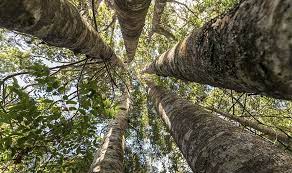Protect our Kauri
Kauri are a cornerstone of the indigenous forests of the upper North Island. They are also one of the longest-living tree species in the world (reaching ages of 1000 years-plus), as well as the largest.
Waiheke Island is currently free of the deadly disease killing our mature Kauri trees, let’s keep it that way!
Before arriving on Waiheke – please ensure you have thoroughly scrubbed any footwear you are bringing to Waiheke.
This is to ensure that no contaminants are brought in to an area, and also to ensure we keep Kauri Die-back disease off Waiheke.
This is how we will stop infected material coming to Waiheke from contaminated areas like the Waitakere Ranges. This material could remain viable for many years, even if it is spread to a footpath or ferry terminal etc. During the Sculpture walk you will encounter ‘walk through’ cleaning stations manned by our volunteers. The walk through stations contain a solution called Sterigene. Sterigene is a non-toxic, biodegradable solution – a veterinary grade disinfectant.
What you can do to help
Please ensure your footwear is thoroughly cleaned before arriving on Waiheke Island. There are cleaning stations at Pier 2 at the downtown wharf, and at Half Moon Bay and Wynyard Wharf. Please support our volunteers and the Sculpture on the Gulf event in our efforts to help keep Kauri dieback off our beautiful Island by helping us with the process of utilising the walk through stations. Note that it is a requirement for us to do this, even if you have already cleaned your shoes prior to arriving on Waiheke.
Kauri Dieback (KDD) is a fungus-like disease that is specific to kauri and kills trees of all ages and sizes. It is spread mainly through soil movement on equipment such as footwear, machinery and mountain bikes.
The spores are truly tiny (10,000 to a pinhead by size), can remain viable for up to 10 years without a host, and anything that touches the ground can carry them. So it is critical that all equipment on each walk, including boots and walking poles are cleaned thoroughly every time they are used.
The microscopic spores in the soil can infect kauri and damage the tissues that carry nutrients within the tree. Infected trees show a range of symptoms including yellowing of foliage, loss of leaves, dead branches and lesions that bleed gum at the base of the trunk. Infected trees may have no symptoms.
This disease is currently incurable.
Nearly all infected kauri eventually die.

Why is it so important?
Without action to control the spread of this disease, we may lose the kauri forest ecosystem for good. Kauri trees are national icons for all New Zealanders and important for our eco-tourism. They are taonga (treasure) of great significance to Māori. Entire ecosystems depend on this significant species.
Where is it?
Kauri dieback has been found around the Auckland region, on the Coromandel Peninsula and Great Barrier Island and in Northland forests. It is currently undetected on Waiheke Island, however infected kauri can remain non-symptomatic for long periods after contracting kauri dieback, so all kauri need to be treated as though they could be infected.

